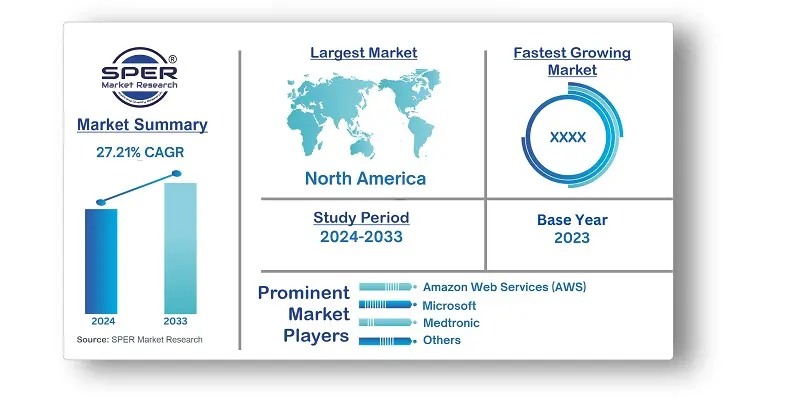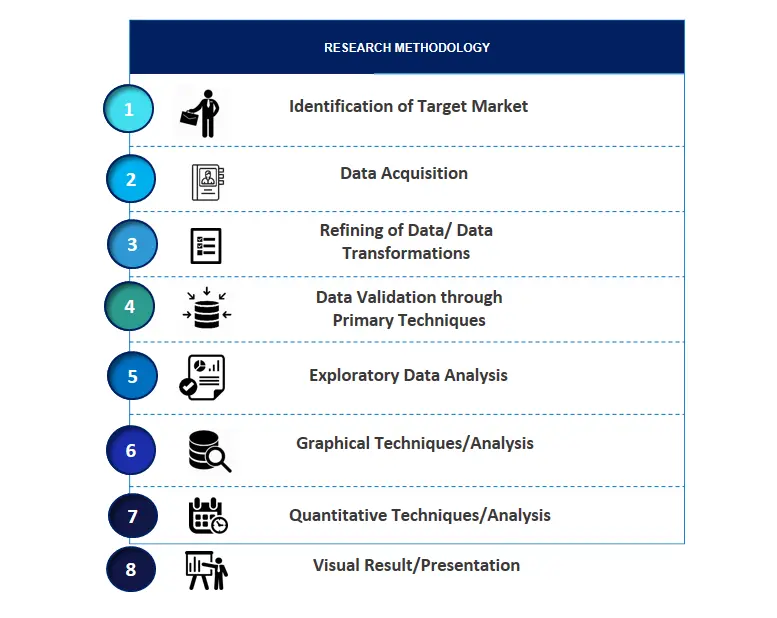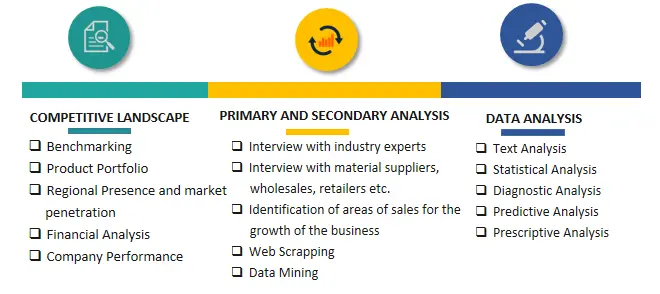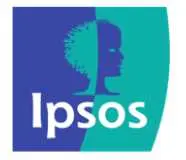
Healthcare Cognitive Computing Market Trends, Share, Size, Demand, Revenue and Future Outlook
Healthcare Cognitive Computing Market Growth, Size, Trends Analysis - By Component, By Application, By End-User, By Deployment Model, By Technology - Regional Outlook, Competitive Strategies and Segment Forecast to 2033
| Published: Dec-2024 | Report ID: HLCA2499 | Pages: 1 - 268 | Formats*: |
| Category : Healthcare | |||
- The general software NVIDIA AI Enterprise-IGX with NVIDIA Holoscan was made available on the NVIDIA IGTX platform by NVIDIA Corporation in June 2024. NVIDIA IGX with Holoscan is used by businesses like Medtronic and Barco to provide AI-powered medical diagnostic solutions.
- The expansion of Medtronic's cooperation with Cosmo Intelligent Medical Devices of Cosmo Pharmaceuticals was announced in December 2023. Using AI technologies, the collaboration contributed to the transformation of endoscopy. In order to expedite medical AI procedures, the collaboration concentrated on using platforms like AI Access, which was made to host numerous third-party applications.


| Report Metric | Details |
| Market size available for years | 2020-2033 |
| Base year considered | 2023 |
| Forecast period | 2024-2033 |
| Segments covered | By Component, By Application, By End-User, By Deployment Model, By Technology. |
| Regions covered | North America, Asia-Pacific, Latin America, Middle East & Africa and Europe. |
| Companies Covered | IBM, Microsoft, Amazon Web Services, Medtronic, SAP, Oracle, Koninklijke Philips N.V., Hewlett Packard Enterprise, Cerner Corporation, Siemens Healthineers. |
- Healthcare Providers
- Pharmaceutical Companies
- Health IT Companies
- Government and Regulatory Bodies
- Academic and Research Institutions
- Insurance Companies
- Patients and Caregivers
- Healthcare Equipment Manufacturers
- Telehealth Service Providers
| By Component: | |
| By Application: | |
| By End-User: | |
| By Deployment Model: | |
| By Technology: |
- Global Healthcare Cognitive Computing Market Size (FY’2024-FY’2033)
- Overview of Global Healthcare Cognitive Computing Market
- Segmentation of Global Healthcare Cognitive Computing Market By Component (Hardware, Software, Services)
- Segmentation of Global Healthcare Cognitive Computing Market By Application (Drug Discovery and Development, Clinical Research, Precision Medicine, Medical Imaging, Diagnostics)
- Segmentation of Global Healthcare Cognitive Computing Market By End-User (Healthcare Providers, Pharmaceutical and Biotechnology Companies, Medical Research Institutions)
- Segmentation of Global Healthcare Cognitive Computing Market By Deployment Model (Cloud-based, On-premises)
- Segmentation of Global Healthcare Cognitive Computing Market By Technology (Machine Learning, Deep Learning, Natural Language Processing, Computer Vision)
- Statistical Snap of Global Healthcare Cognitive Computing Market
- Expansion Analysis of Global Healthcare Cognitive Computing Market
- Problems and Obstacles in Global Healthcare Cognitive Computing Market
- Competitive Landscape in the Global Healthcare Cognitive Computing Market
- Impact of COVID-19 and Demonetization on Global Healthcare Cognitive Computing Market
- Details on Current Investment in Global Healthcare Cognitive Computing Market
- Competitive Analysis of Global Healthcare Cognitive Computing Market
- Prominent Players in the Global Healthcare Cognitive Computing Market
- SWOT Analysis of Global Healthcare Cognitive Computing Market
- Global Healthcare Cognitive Computing Market Future Outlook and Projections (FY’2024-FY’2033)
- Recommendations from Analyst
1.1. Scope of the report1.2. Market segment analysis
2.1. Research data source
2.1.1. Secondary Data2.1.2. Primary Data2.1.3. SPERs internal database2.1.4. Premium insight from KOLs
2.2. Market size estimation
2.2.1. Top-down and Bottom-up approach
2.3. Data triangulation
4.1. Driver, Restraint, Opportunity and Challenges analysis
4.1.1. Drivers4.1.2. Restraints4.1.3. Opportunities4.1.4. Challenges
4.2. COVID-19 Impacts of the Global Healthcare Cognitive Computing Market.
5.1. SWOT Analysis
5.1.1. Strengths5.1.2. Weaknesses5.1.3. Opportunities5.1.4. Threats
5.2. PESTEL Analysis
5.2.1. Political Landscape5.2.2. Economic Landscape5.2.3. Social Landscape5.2.4. Technological Landscape5.2.5. Environmental Landscape5.2.6. Legal Landscape
5.3. PORTERs Five Forces
5.3.1. Bargaining power of suppliers5.3.2. Bargaining power of buyers5.3.3. Threat of Substitute5.3.4. Threat of new entrant5.3.5. Competitive rivalry
5.4. Heat Map Analysis
6.1. Global Healthcare Cognitive Computing Market Manufacturing Base Distribution, Sales Area, Product Type6.2. Mergers & Acquisitions, Partnerships, Product Launch, and Collaboration in Global Healthcare Cognitive Computing Market
7.1. Global Healthcare Cognitive Computing Market Size, Share and Forecast, By Component, 2020-20267.2. Global Healthcare Cognitive Computing Market Size, Share and Forecast, By Component, 2027-20337.3. Hardware7.4. Software7.5. Services
8.1. Global Healthcare Cognitive Computing Market Size, Share and Forecast, By Application, 2020-20268.2. Global Healthcare Cognitive Computing Market Size, Share and Forecast, By Application, 2027-20338.3. Drug Discovery and Development8.4. Clinical Research8.5. Precision Medicine8.6. Medical Imaging8.7. Diagnostics
9.1. Global Healthcare Cognitive Computing Market Size, Share and Forecast, By End-User, 2020-20269.2. Global Healthcare Cognitive Computing Market Size, Share and Forecast, By End-User, 2027-20339.3. Healthcare Providers9.4. Pharmaceutical and Biotechnology Companies9.5. Medical Research Institutions
10.1. Global Healthcare Cognitive Computing Market Size, Share and Forecast, By Deployment Model, 2020-202610.2. Global Healthcare Cognitive Computing Market Size, Share and Forecast, By Deployment Model, 2027-203310.3. Cloud-based10.4. On-premises
11.1. Global Healthcare Cognitive Computing Market Size, Share and Forecast, By Technology, 2020-202611.2. Global Healthcare Cognitive Computing Market Size, Share and Forecast, By Technology, 2027-203311.3. Machine Learning11.4. Deep Learning11.5. Natural Language Processing11.6. Computer Vision
12.1. Global Healthcare Cognitive Computing Market Size and Market Share
13.1. Global Healthcare Cognitive Computing Market Size and Market Share By Region (2020-2026)13.2. Global Healthcare Cognitive Computing Market Size and Market Share By Region (2027-2033)13.3. Asia-Pacific
13.3.1. Australia13.3.2. China13.3.3. India13.3.4. Japan13.3.5. South Korea13.3.6. Rest of Asia-Pacific
13.4. Europe
13.4.1. France13.4.2. Germany13.4.3. Italy13.4.4. Spain13.4.5. United Kingdom13.4.6. Rest of Europe
13.5. Middle East and Africa
13.5.1. Kingdom of Saudi Arabia13.5.2. United Arab Emirates13.5.3. Qatar13.5.4. South Africa13.5.5. Egypt13.5.6. Morocco13.5.7. Nigeria13.5.8. Rest of Middle-East and Africa
13.6. North America
13.6.1. Canada13.6.2. Mexico13.6.3. United States
13.7. Latin America
13.7.1. Argentina13.7.2. Brazil13.7.3. Rest of Latin America
14.1. IBM
14.1.1. Company details14.1.2. Financial outlook14.1.3. Product summary14.1.4. Recent developments
14.2. Microsoft
14.2.1. Company details14.2.2. Financial outlook14.2.3. Product summary14.2.4. Recent developments
14.3. Amazon Web Services
14.3.1. Company details14.3.2. Financial outlook14.3.3. Product summary14.3.4. Recent developments
14.4. Medtronic
14.4.1. Company details14.4.2. Financial outlook14.4.3. Product summary14.4.4. Recent developments
14.5. SAP
14.5.1. Company details14.5.2. Financial outlook14.5.3. Product summary14.5.4. Recent developments
14.6. Oracle
14.6.1. Company details14.6.2. Financial outlook14.6.3. Product summary14.6.4. Recent developments
14.7. Koninklijke Philips N.V
14.7.1. Company details14.7.2. Financial outlook14.7.3. Product summary14.7.4. Recent developments
14.8. Hewlett Packard Enterprise
14.8.1. Company details14.8.2. Financial outlook14.8.3. Product summary14.8.4. Recent developments
14.9. Cerner Corporation
14.9.1. Company details14.9.2. Financial outlook14.9.3. Product summary14.9.4. Recent developments
14.10. Siemens Healthineers
14.10.1. Company details14.10.2. Financial outlook14.10.3. Product summary14.10.4. Recent developments
14.11. Others
SPER Market Research’s methodology uses great emphasis on primary research to ensure that the market intelligence insights are up to date, reliable and accurate. Primary interviews are done with players involved in each phase of a supply chain to analyze the market forecasting. The secondary research method is used to help you fully understand how the future markets and the spending patterns look likes.
The report is based on in-depth qualitative and quantitative analysis of the Product Market. The quantitative analysis involves the application of various projection and sampling techniques. The qualitative analysis involves primary interviews, surveys, and vendor briefings. The data gathered as a result of these processes are validated through experts opinion. Our research methodology entails an ideal mixture of primary and secondary initiatives.



Frequently Asked Questions About This Report
PLACE AN ORDER
Year End Discount
Sample Report
Pre-Purchase Inquiry
NEED CUSTOMIZATION?
Request CustomizationCALL OR EMAIL US
100% Secure Payment






Related Reports
Our Global Clients
Our data-driven insights have influenced the strategy of 200+ reputed companies across the globe.




















